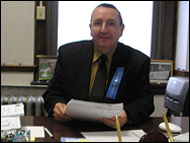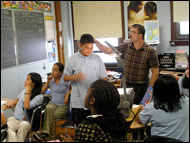 | |||||||||||
| |||||||||||
|
|||||||||||
Blue Ribbon Honor Crowns "A Cinderella Year" for Conwell Middle School
| ||||||||||||||||||||||||||
The leader of Philadelphia's Conwell Middle School is truly a homegrown talent. Born and raised only a block away, in the house where he still lives to this day, Edward Hoffman began his own education at Conwell in 1953, when it was an elementary school. He returned in 1980 as an English teacher and became principal in August 2004.
"'The story could end there, and it would be a great story,'" Hoffman proudly recalls a school district official saying at an administration meeting. "'But it gets even better,' he said. 'In the five years that Mr. Hoffman's been principal, scores have gone through the roof. And now he's going to fly the national Blue Ribbon flag over the school.'"
This fall, Conwell—an inner-city magnet school that serves 871 students in grades 5-8—became one of 320 schools across the nation honored by the U.S. Department of Education as a No Child Left Behind-Blue Ribbon School. Ranking in the top 10 percent of Pennsylvania public schools based on the state exam results, it was the only middle school in the state to receive the federal award this year.
 Principal Edward Hoffman and the notable gems that decorate his desk. Photos courtesy of Conwell Middle Magnet School.  Students read in the school library.  Michael Rocco instructs a seventh-grade social studies class. |
"It's been a Cinderella year," says Hoffman, who also won the Department's Terrel H. Bell Award for outstanding leadership at the Blue Ribbon ceremony in Washington in October. The national designation, he explains, has elevated the school's status, as has the record achievement made by eighth-graders this past spring.
On the Pennsylvania System of School Assessment, approximately 97 percent of Conwell graduates scored proficient and above in reading, and 93 percent did so in math, nearly double the district average in both subjects. More impressive, the percentage of eighth-graders performing at the advanced level in reading has risen from 29 percent in 2004 to 77 percent in 2008, and in math from 13 percent to 67 percent.
Since Hoffman took the helm, Conwell has exceeded the state's adequate yearly progress (AYP) targets every year. According to the latest data, overall student proficiency in reading is at 84 percent and in math at 88 percent.
As a magnet school, Conwell has admissions requirements that enable it to admit students from the 70th percentile of their elementary school class or higher. While these selective admissions criteria require above-average academic, attendance and behavior records, Hoffman will accept students' siblings regardless of their school history and even children with suspension records if they say they will work hard.
"It's different here," he says. "You don't get the easy A's for smiling, behaving, looking cute. You have to participate."
The impressive test results reflect the rigor of the four-year academic program at Conwell. Holding up a data sheet, a statistical snapshot of the school's success he often shares with parents, Hoffman measures progress not by benchmark proficiency rates but by the percentage of students performing at the highest level possible. He points out, for instance, how in their first year at the school just 9 percent of fifth-graders scored at the advanced level in reading, and now 77 percent of those students, who in 2008 were in the eighth grade and ready to move on to high school, were performing at the top level.
That is no ordinary feat considering the school's high poverty rate, with nearly three-fourths of the students qualifying for federally subsidized meals, and its highly diverse student body of mostly black, white and Hispanic students, along with a handful of Asian and American Indian children.
"To have a school with so many different types of backgrounds, and then to have those children be able to work together and help each other and look out for one another, I thought that was really special," says music teacher Renee Singletary, a 30-year veteran teacher who joined the staff in 2001, about her first impression of the school.
Singletary, whose granddaughter is enrolled at Conwell, believes Hoffman is a major reason for the continual progress of this large, heterogeneous school community. "Children come first with him," she says.
But Hoffman shies away from accepting the credit. "It's not me," he quickly responds, "I've got great teachers. I've got tremendous students."
Conwell's staff includes teachers well past the retirement age who have been at the school for more than 40 years. And, with teacher turnover considerably low, Hoffman says the school feels like a family, which is why the entire faculty, along with some community partners, petitioned the superintendent four years ago to appoint Hoffman to succeed its ailing administrator. Under his leadership, they wanted to save their beloved school from a district plan to transition middle schools to K-8 or small high school configurations.
Founded in 1928 as an elementary school in the Kensington section of Philadelphia, a working class neighborhood, Conwell was converted into a middle magnet school in 1969, believed to be the first of its kind in the country.
It was named after Russell H. Conwell, who was most famous for founding the city's Temple University, which was funded largely by income from his notable "Acres of Diamonds" speech, which he delivered more than 6,000 times. Conwell's message that the discovery of fortune does not begin abroad but in one's own community is a motif that Hoffman and his staff have adopted using artificial gems as decorations throughout the school and as awards for the children.
"I say we have 871 diamonds in our backyard because they're our precious gems," Hoffman says.
Conwell's educators have had to be resourceful in maximizing the space of a 60-year-old school as well as that of its annex. For example, to accommodate an average of 33 students per class, the bigger rooms have been assigned to the teachers who have the longer class periods, which are the 90-minute blocks for reading and math. The open space of a former art studio in the annex has been partitioned into three classrooms, which Hoffman says astounds visitors when they see that the children are not distracted by the simultaneous lessons.
And, Hoffman reconfigured the learning space based on a conversation he had with a principal from England who bragged that British children were more advanced than those in the United States because British educators were "not looking at teaching anymore ... [but rather] at what the kids are doing ... learning ... understanding."
Hoffman replaced, where possible, the single-chair desks with small tables and chairs, grouping four students at each table, so that the learning process became an active collaboration between the teacher and student as well as among groups of students.
"If everybody's facing you, and they're listening to you," he says of the traditional teacher-centered classroom format, "I walk into the room and I only see how knowledgeable you are."
This cooperative learning approach has drawn students out of academic isolation by engaging them in activities that call for them to work together toward a common objective. For example, in math, teams at each table solve a series of story problems using a specific strategy taught earlier in the class. During this time, teachers canvas the room observing and giving guidance.
Also, the cooperative approach has compelled students to take greater ownership of their learning through roles as facilitators, timekeepers, organizers and summarizers assigned to each group. Educators count other benefits: increased student motivation and confidence, and the opportunity to develop skills in teamwork and advanced thinking. Hoffman says his teachers, who found the instructional method immediately effective, were amazed at "the level of questions the kids were asking."
Another significant change Hoffman made as the school's new administrator was to make the curriculum more rigorous. He accelerated the pacing of core content instruction to move students beyond mastering the fundamental standards required at each grade level toward attaining "a higher order of thinking," he says, that involves analyzing issues critically, engaging in independent research, and working collaboratively on projects.
Building on this rigor, a couple of years ago Hoffman added Spanish courses for seventh- and eighth-graders and brought in secondary school teachers as part of a plan to expand Conwell into a high school. Although the plan was not approved, Hoffman says, bringing in high school teachers "has only helped us, because now I sit in an eighth-grade room and I see teaching at a 10th-grade level."
John Palmer was one of the secondary-level educators hired. A former mechanical engineer who entered the education field through the federally funded Transition-to-Teaching Program, Palmer teaches an accelerated pre-algebra class, which allows students in eighth grade to earn high school credit and go directly into geometry or algebra II. "I always thought back and appreciated my math teachers for what they'd enabled me to do," Palmer says. "And I thought, hmm, maybe I could do the same."
Hoffman also supplemented the curriculum with a new initiative called "Emerging Scholars," a multidisciplinary program that uses research-based practices to demonstrate to students the real-world application of classroom knowledge. The program was created as an after-school enrichment opportunity by Philadelphia Public Schools, but it lacked the funding needed to launch it. However, Hoffman was so impressed with the concept that he found resources at the school to form its own version.
Conwell's Emerging Scholars initiative runs on Tuesdays and Thursdays during the school day to ensure all children can participate, particularly those with commitments after school. Students choose from a list of offerings that explore, among other topics, global warming, baseball statistics, Web design, poetry writing and music theory.
In Michael Rocco's workshop, "It's a Culture Thing," students will publish a book of words specific to cultures represented in their school, neighborhood and families. Rocco also uses an exploratory learning approach in his seventh-grade social studies class, with homework assignments that challenge his students to survey the world around them.
"Those homework assignments to me are a chance for the kids to use their heads and get away from just putting their noses in a book," he says.
The recruitment of Rocco, who was teaching at one of the city's prominent magnet high schools before coming to Conwell, awes Hoffman, as do the other changes that have transpired since their efforts to save their school five years ago.
Counting the crowning accomplishments, Hoffman says, "the [Blue Ribbon] flag flying over our head, the city recognizing us, now other teachers and other schools wanting to get their children in here ... the fact that we can take these children and raise the scores in these ways [says] we've got something special going on in our school."
Unsubscribe
To unsubscribe from The Achiever:
- Send email to listserv@listserv.ed.gov
- Write in the body of the message: unsub nochildleftbehind
|
|
|
|||||||||||
| |
||||||||||||

